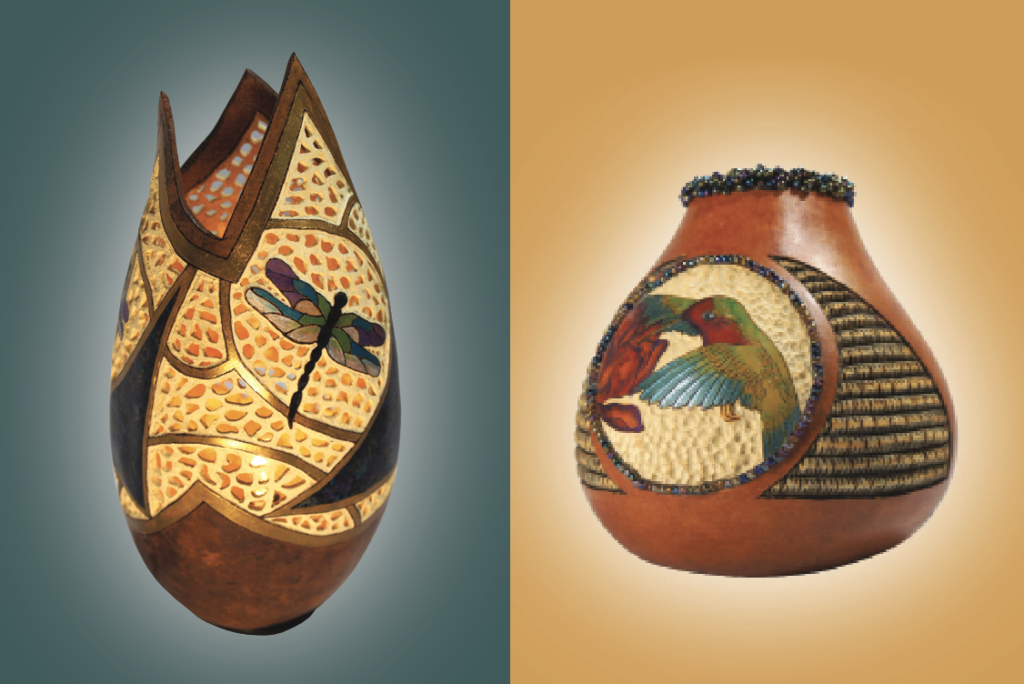Article:
CELEBRATING GOURDS
BY ANITA B. STONE
PHOTOS BY BARBARA BURNS
One of North Carolina’s most venerable gardening clubs focuses not on roses or other flora traditionally associated with horticultural societies, but on a plant that offers great scope for the creative imagination: gourds. The North Carolina Gourd Society (NCGS) has spent most of a century elevating gourds to one of the state’s most recognized fruits. On September 7–8, the society will hold the 82nd North Carolina Gourd Arts & Crafts Festival at the North Carolina State Fairgrounds in Raleigh.
Cary: Gourd Capital of the World
The NCGS, originally known as the Gourd Gardeners and then as the Gourd Village Garden Club, began in Cary in 1937, making it one of the oldest garden clubs in the state. It is also the oldest chapter of the American Gourd Society. The society met at the location that is now The Albatross on Chatham Street, and its activity led to Cary’s being nicknamed the Gourd Capital of the World for a time, a designation that even appeared on Cary’s town seal in 1964. The society’s first gourd festival was held in 1938. Early festivals were held wherever space was available—in a school cannery, a dry cleaner and a furniture store. The society took the name North Carolina Gourd Society in 2000, the year it moved its annual festival to the state fairgrounds in Raleigh.
During its formative years, the society used the festival to promote gourds as an organic and sustainable farm product that could be used in multiple settings. Today, it continues to educate the public on how and why to grow and use gourds. “They are so easy to grow and maintain,” offers Judi Fleming, the society’s president. “Nowadays, our purpose is to offer classes [for beginners and the general public to advanced growers] to capture the beauty of gourds in the areas of painting, carving, weaving, coiling, wood burning and utility usage. We also offer exhibits and growing tips while teaching about this versatile fruit. You can always contact a grower or a society member to purchase gourds, seeds, art supplies, tools and books, as well as gourd crafting kits.”

Tips for Cultivating Gourds
Gourds are among the oldest cultivated plants. “They are a warm weather crop,” says Fleming. “Early water bottles were carved from hard gourds and used as vessels by [Native American] tribes of North Carolina. They have also been used as storage containers and dippers for centuries.”
Gourds, squash, melons and cucumbers are all cucurbits—warm-season, frost-sensitive plants that grow on vines. Gourds grow in many varieties of shape, size and color.
Fleming offers tips for successfully growing gourds:
- Make sure you plan out your space. If you do not plan carefully, gourds will take over your yard. Make sure to plan in a sunny area, as gourds require at least six hours of sunlight per day.
- Plant seeds in the spring at least two weeks after your average last frost date passes, but don’t wait too long, as they take 100–180 days to mature. Plant groups of four seeds directly into the ground at ½ inch soil depth. Make sure to incorporate compost into the soil.
- Water thoroughly at least once a week—more if there is a dry spell. Prevent pests such as beetles and powdery mildew by using homemade sprays or insecticides. Spray every week. You can also use row covers to protect your gourds.
- Fertilize your seeds with a balanced fertilizer of compost manure when the vines begin to bloom.
- Some people use trellises or tomato cages to grow lighter gourds. This approach will not work well for heavier ones.
- Harvest your gourds when the vine begins to turn brown where it meets the gourd. When cutting a gourd from the vine, leave two inches of the stem to ensure you have a good handle for your gourd. If you cut the gourd too early, you increase the risk that it will rot.
- Once you have harvested the gourd, store it in a well-ventilated, dry area with temperatures between 55–65 degrees Fahrenheit. Gourds survive well in root cellars, attics, garages or barns. Leave them to dry for one to six months if you plan to use them for crafts or other projects. When the gourd turns brown and the seeds rattle around in it, it is ready to use.

Creating with Gourds
Creative work with gourds can begin as they grow. “Have fun shaping gourds,” suggests Fleming. “For instance, you can place a broomstick on the ground and train the stems to grow around the stick, giving the gourd stems a curved appearance. You may also want to tie the neck of larger gourds in knots for an unusual look.”
Gourds can be used as ornaments for the home and as vessels for food and water. People paint them to use as small items such as keychains and make large gourds into birdhouses. The possibilities are endless. “Have fun and create different kinds of gourds for many uses,” says Fleming.
The North Carolina Gourd Arts & Crafts Festival offers many creative ideas and opportunities for growing and crafting gourds. Participants can take classes, buy gourds for craft use, buy gourd swag, and of course view the many creative household and yard items and works of art that local crafters have created with gourds. Ambitious crafters can participate in a competition, and children can enjoy gourd-related crafting projects. So head out to the state fairgrounds September 7–8 and explore the many creative possibilities related to North Carolina’s beloved, versatile fruit.
Learn more about the North Carolina Gourd Society and the North Carolina Gourd Arts & Crafts Festival at ncgourdsociety.org.




